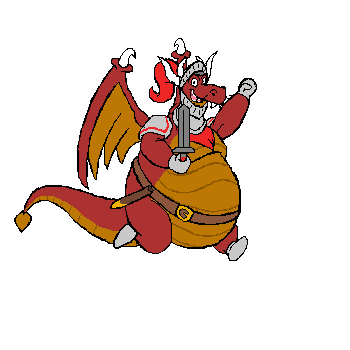
Dueling Dragon Demo
Grab your sword, shield, and a pinch of courage and take a fantastical journey into how I was able to turn a dream and pixels into a playable video game demo!
Getting Started
A lot of work and hours went into creating Dueling Dragon, the project that I am most proud of during my time at Quinnipiac. The first assignment of the week was to write down fifty (yes, 50) game titles and select twenty to write a brief synopsis about. I did this by creating various alliterations with each letter in the alphabet twice, hence names like K.O. Kangaroo, Dino Debonair, Iguana Ice Cream, Harold Hyena, and of course, Dueling Dragon. These were the five main games that I chose to explore a little further, receiving their mockup logos before making a final direction. As you can already tell, Dueling Dragon won the hearts of my peers and was officially on its way to becoming its mini-demo by the end of the semester!
Next, we were tasked with creating our first mood board, which would help us and our audience start to understand the overall feel we were aiming to achieve in the final product. As evident in my mood board, I chose to focus my palette primarily on various reds and blues to correspond with the stereotypical “good” and “evil” tropes that we see in media. However, I wanted to go against those norms and have our hero, the dragon, wear red and the villain wears blue. Why can’t red be the good guy? Since I wanted our big scaly knight to be victorious and rescue the princess by the end of the game (a character who also wears blue to compliment her prince), I wanted purple to symbolize when the red and blue finally come together for a happily ever after.
Before getting into the fun stuff, I needed to revise my final logo, as some of the feedback was that it seemed a little too generic for a game that sounded like it had so much promise. Rather than scrap the theme I had already established, I wanted to build further upon the medieval castle aesthetic, but to have it tell a story of its own and draw audiences in to try it for themselves. But even then, I wanted to subvert people’s expectations by revealing that they are playing as the dragon dueling the prince to protect his love, the princess. After producing fifteen rather good sketches, I finally had myself a winner!
Bringing a Dragon to Life
Now here’s where things get interesting! With a logo in hand, I began to create a rough storyboard of cutscenes and events that would take place in the game. “What was the plot?” “Where and when were events taking place in accordance with one another?” “Why did characters make the decisions that they did?” “What are the consequences of their actions?” “How would our hero get from point A to point B?” Unfortunately, there was not enough time in the semester to fully expand upon these ideas, but my storyboards allowed me to expand upon the world further and get to know the characters in it. I wanted them to feel something when looking at these boards and transport them into a realm of imagination and fun, and thankfully I managed to do just that!
These storyboards are also the first time our big scaly hero was given a proper design, as all past appearances were merely his silhouette. With this, Dudley the Dragon became the larger-than-life hero that he is known to be today. Complete with an impressive and intricate display of horns atop his head, a set of armor to call his very own, and a fancy little mustache, he was ready to defeat “The Lovely Prince Charming” and rescue the fair princess.
The next part of the process was creating the GUI elements of my game, such as the main menu and settings screen. While not as significant when compared to the essential gameplay elements yet to come, I took great care in designing them to fit the theme of a medieval dungeon within a children’s storybook. No matter what age you are playing this game, I wanted to be able to rekindle the whimsical magic in people’s lives that brought out their inner child.
At last, we get to my favorite part of this project: the sprite animation. Using the program Aseprite, I created Dudley’s idle, running, and jumping animations. However, in the final product, there would be many other animations to bring him to life. I could go on all day about the little ins and outs of how I created each, but I will focus primarily on Dudley’s running animation to save time, which was the most challenging one. I needed to keep his proportions as on-model as I possibly could while he was in motion. Not to mention that he turns towards a slight diagonal towards the camera and leans forward when he starts moving to emphasize his tremendous weight and the momentum that he is picking up as he runs. This is further helped by his body bouncing up and down as he lands, his tail swishing as it follows behind him.
My initial attempt was successful, but he still seemed a little too static for my liking. I carefully went back in and tweaked some frames, such as moving him up slightly and then back down across a few extra boundaries to create a little hop as he runs and some additional structures for blinking to breathe life into him. His little tongue protruding from his snout is my favorite detail, though. He’s a big red goober on a noble quest! I am proud of those animations to this very day, as it was my first experience with pixel art and properly animating with it.
Tying Everything Together
With Dudley finally ready to jump into action, I used him as my foundation for my second mood board. This board focused primarily on the kind of castle architecture I wanted to create for my environment based on how other games have made it. While the demo does take place in Prince Charming’s castle (consisting of royal blues and gallant golds), the pictures I found were to show the go-to design choice when making an antagonist’s castle. Notice how they have read somewhere in them and are cast in dark, eerie shadows to make sure you know that this place belongs to a bad guy? I wanted to do the exact opposite. I wanted Prince Charming’s castle to be as well-lit and clean as possible, with blue and gold found in tapestry and carpeting throughout the court to clash with stereotypes we have created for others.
Once my tilemap was finished, animations were appropriately connected and reacted appropriately to inputs, 2D camera coding, and some minor collision detecting work for those graceful landings; I finally had it; a game to call my very own. While coding isn’t the most vital skill in my repertoire, I am pleased to say that it was serviceable enough to create the product that it is today. If it is at all possible, I would love to expand upon what I have today and make my own indie game!
If you would like to try the demo for yourself, you can click the button below and download the Mac and Windows versions from my Dropbox. Safe travels, adventurer!













